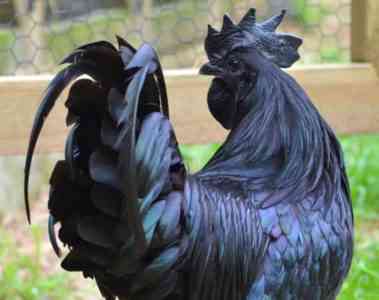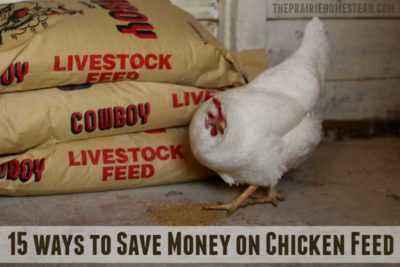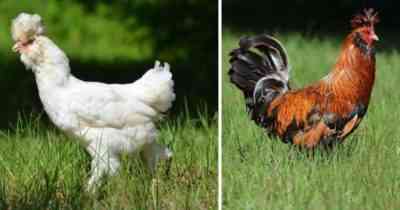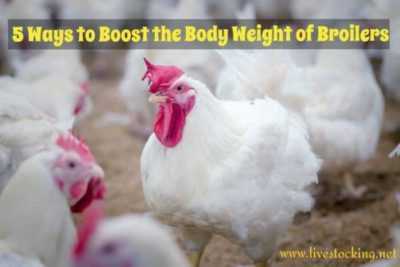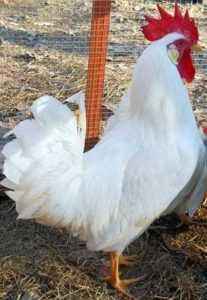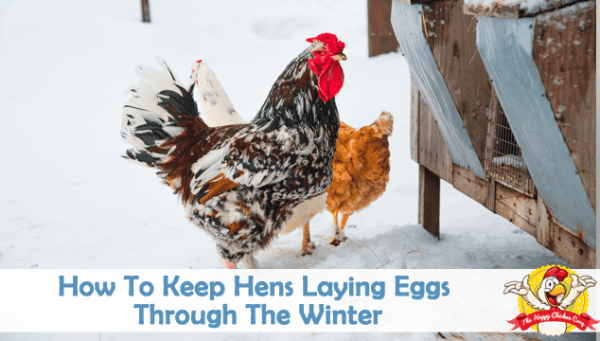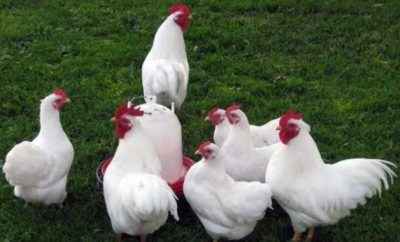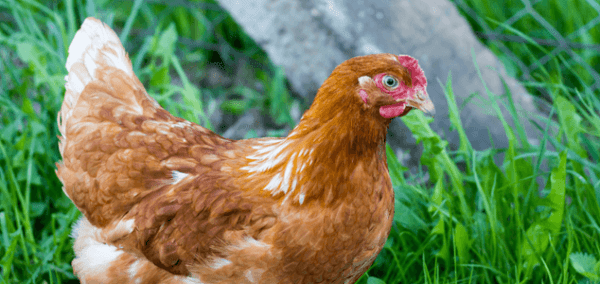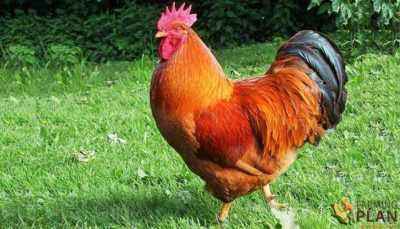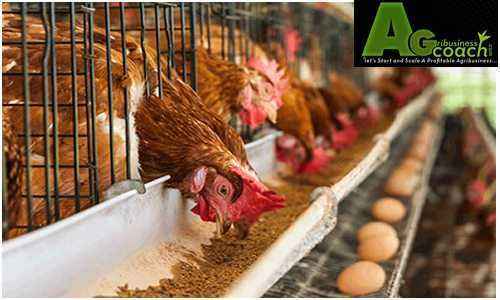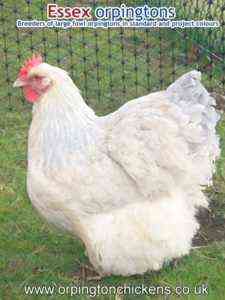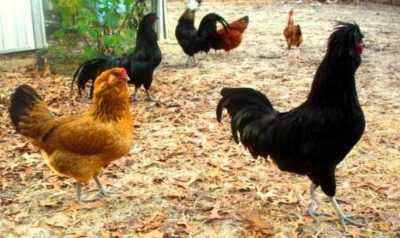Diseases of the eyes in chickens are quite common and occur most often with improper care or maintenance. Swelling of the eyes in the chicken as in the photo, spontaneous closure or purulent discharge should be serious signals for the breeder.Since among these birds, eye diseases are quite easily and almost unhindered, the symptoms of one chicken’s disease can automatically mean an epidemic for the whole chicken coop – therefore, only after seeing such signs, it is necessary to diagnose and treat.
- Types of eye diseases in chickens
- Conjunctivitis in poultry
- Xerophthalmia in chickens
- Eye infections in birds
- Laryngotracheitis <
- Salmonellosis <
- Mick oplasmosis
- Keratoconjunctivitis <
- Various tumors
- Eye injuries
- Marek’s disease
- Ammonia blindness
- Which individuals are most likely to be affected by eye diseases?
- Recommendations

Chickens eye diseases
If one bird closes one eye, this should also serve as an immediate reason to contact a veterinarian, since it is easiest to cure any disease at an early stage. The veterinarian will tell you how to treat chickens in this situation, based on the state of the bird, the neglect of the disease. In more detail, any types of eye diseases in chickens can be seen in the photo or video.
Types of eye diseases in chickens
- Conjunctivitis
- Xerophthalmia
- Infections
- Keratoconjunctivitis
- Various tumors
- Eye injuries
- Marek’s disease
- Ammonia blindness
Conjunctivitis in poultry
The most common and well-known disease for breeders, the most common in chickens is conjunctivitis. Since photographs of hens with this disease can be found on almost every box of eye drops, everyone still knows how it usually looks. If the breeder does not pay attention to injuries or bruises, conjunctivitis in a bird can develop as a result of them – and among the causes of the disease are usually listed:
- Lack of adequate ventilation in the chicken coop.
- Vitamin A deficiency in poultry nutrition.
- High humidity.
Whatever the cause of the disease, its symptoms are always the same. With great difficulty, the chicken lifts the eyelids, her eyes begin to swell, purulent discharge appears. In addition to these signs, there is general fatigue, a lack of any appetite and a deterioration in vision itself, as a result. If you do not treat this disease, it will lead to complete blindness of the bird, the eyes of the chicken atrophy.
In order to prevent the spread of the disease, sick hens need to be transplanted into another cage.In a huge assortment of veterinary pharmacies, there are drugs aimed at getting rid of this disease, but before buying them, you must always consult with experienced specialists. The doctor will prescribe the necessary medication and treatment plan, depending on the condition of the chicken and the course of its disease.
If you find a tumor in the chicken’s eye or signs of conjunctivitis at the initial stage of the disease, it’s enough just to make tea compress for the eyes of chickens. To do this, moisten a small piece of fleece in a well-brewed tea and apply it to the affected eye. Instead of tea, you can use chamomile infusion.
How to treat swollen eyes in chickens? In parallel with compresses for treating birds, you need to provide them with vitamin A. The easiest way to do this is to simply buy it in drops and add to drink. Typically, the vitamin is added at the rate of 0.5 ml per 100 ml of water. In addition to vitamin A itself, chicken nutrition can also be supplied with other vitamins to improve overall well-being. This will positively affect the health of birds and increase their immunity. To prevent the disease, it is worthwhile to provide acceptable living conditions – good food, no drafts or vice versa, lack of air in the room. If medication and proper care do not help, you should consult a specialist.
Xerophthalmia in chickens
If the bird has swollen eyes, but no purulent discharge, they are affected by a disease such as xerophthalmia. In addition to swelling of the eyes, dryness of the cornea and disturbances in the work of the lacrimal glands appear. Since this disease is accompanied by quite different manifestations, any veterinarian will be able to easily determine its presence even from a photo of an ill chicken. The only reason for the onset of this disease is a lack of vitamin A.
During the treatment of this disease there is no need to take any medications – it is enough just to improve nutrition. In some cases, a chicken eye tumor can occur when the bird has received physical bruises. This really happens and with eye injuries, they can swell. To prevent this from happening in the chicken, you must follow the safety precautions on the farm and remove all sharp objects and dry straw from the floor that the birds can stumble on.
Eye infections in birds
Veterinarians strongly recommend not to purchase drugs themselves. All preparations should be prescribed only by a specialist. If symptoms of any infections are detected in birds, the chicken should be shown to a specialist. Eye infections are one of the most common causes of eye swelling in chickens. In case of infections in birds, eye swelling, increased lacrimation, purulent discharge is observed.Depending on what kind of infection the bird is infected with, what exactly are the diseases of the eyes in hens, the treatment and medications used vary.
The most common infections when chickens close their eyes: laryngotracheitis, salmonellosis and mycoplasmosis . If the chicken swells, one eye closes or the bird scratches the area around the eyes, then these are possible signs of various viral infections. According to the behavior of the bird, one can also conclude that unhealthy behavior. If the chickens in the chickens swell their eyes, the bird sits choked, not active and refuses to eat, then this is a reason for further observation. Look into the pupils, if they are cloudy, swollen or swam, then the problem is most likely in eye infections.
Laryngotracheitis
This disease is characterized by its acute course – symptoms appear immediately and almost at full strength, causing inflammation not only of the eyes themselves, but also of all the mucous membranes. If left untreated, conjunctivitis develops, and a fatal outcome for a large number of chickens is also possible. That is why, at the first detection of the symptoms of this infection, the infected bird must be urgently isolated from the rest of the chicken coop in order to avoid spread. This disease is treated with thromexin. The required course of treatment is 5 days. If this does not help, the chicken affected by the infection will have to be chopped.
Salmonellosis
The main dangers of this infection are that salmonellosis is transmitted from birds to humans, and even chickens can get this disease. When working with a sick chicken, it is necessary to observe safety and disinfect all clothing, gloves. Salmonellosis is characterized by symptoms that are quite similar to conjunctivitis – swollen eyes, decreased appetite, and among the symptoms are lameness and characteristic wheezing in the bird. Salmonellosis is treated strictly with antibiotics prescribed by the veterinarian. Individuals who have suffered salmonellosis remain carriers of the virus for at least 4 months.
Mycoplasmosis
This infection is a consequence of a running cold when the bird’s eye has swollen. If you do not pay attention in time to the fact that the chickens have a cold, this will turn into mycoplasmosis, which can be seen in the photo on the Internet. During this infection, it is difficult for the bird to breathe, it develops swelling of the mucous membranes, runny nose, and swollen eyes. Can meet in adult hens and chickens. Mycoplasmosis is treated with a course of antibiotics , but it is worth starting this treatment only when you are sure that you are faced with this particular infection. The difficulty is that it does not have its own symptoms. It is difficult to recognize, as a runny nose and swelling can be symptoms of other diseases. If the treatment does not lead to recovery, diseased hens need to be chopped off.
Keratoconjunctivitis
The peculiarity of this disease in its cause is that it appears due to inhaled toxic fumes (for example, fumes of any chemical agents). The disease is not transmitted among birds. It goes through several stages: the cornea becomes cloudy in chickens, after which an eyesore appears and secretions reminiscent of foam in consistency. Appetite decreases, general lethargy and fatigue appear. It is very important that the veterinarian determines the specific type of the disease, whether or not keratoconjunctivitis is purulent, especially if the chicken has both eyes festering.
In addition to the prescribed course of antibiotics, corticosteroids are used to treat this disease. Along with this, eye washings are performed with antiseptic effects. Prevention of this disease consists in proper ventilation of the room, attention to living conditions, isolation of birds from rooms in which disinfection is performed .
Various tumors
Causes of ocular tumors in chickens are still not exactly understood. For the most part, they look more like a bump than edema. Their appearance is accompanied by inflammation, then they swell. If you see that the bird’s eyes are red and swollen, but no other symptoms are observed in the sick individual, the infection can be immediately excluded from the list of possible diseases. The same can be said about inflammatory processes, accompanied by lacrimation and purulent discharge.
If the eyes are inflamed in chicken or adult broilers, then the treatment will be a little different. Small individuals are still too weak to fight disease. Unfortunately, at the moment there are no drugs that would help get rid of the tumor. If the bird eats well, then you need to focus on the preparation of its diet. Add to it more of her favorite treats, as well as fortified supplements. Treatment consists only in surgical removal of the tumor, which must be trusted by qualified, trusted specialists.
Eye injuries
Such injuries they are dangerous in that if the eye is not treated and it rots, it can lead to infection of the whole organism.Mostly various injuries, birds get from each other, while walking, or even after jumping from their perch. Often such injuries can be observed in a rooster, as they are more fighting and more often than others enter into a fight. Of course, it is difficult to seriously injure the area around the eyes, but an infection can get through the wound and this will cause various diseases. After an injury or an open wound, the eyes become inflamed, and in this case, swelling and inflammation must be removed.
The most important thing is to notice the injury in time, then serious problems can be avoided.Its main symptom is possible bruising, abrasion. Accompanied by impaired lacrimal glands, redness of the eyelids and loss of the third century. The first thing to do when you notice an injury is to rinse the wound. Washing is carried out using eye drops, chlorhexidine or a solution of boric acid. After washing, carefully examine the affected bird’s eyes. If you see any foreign objects in your eyes, be sure to get them out. Naturally, this procedure is extremely undesirable to carry out on your own – it should be entrusted to a veterinarian who will remove foreign objects from the eyes under anesthesia, but this is easier than if the chickens have seriously ill eyes associated with the infection.
Marek’s disease
In broilers, this disease is not uncommon. Marek’s disease is a viral disease that can spread throughout the livestock. If at least one individual became ill with such a disease, then it must be placed in a separate room until complete recovery, otherwise such individuals are considered carriers of the virus. In broilers, symptoms appear as follows:
- Birds lose their eyesight
- Kura sluggish
- Head poorly held
- Pupil decently narrowed
- The nervous system is affected
If this disease is not treated, then the large Marek virus can completely deprive the chicken of vision, this can be seen in the photo. For sick individuals, treatment has not yet been invented, despite the constant progress in medicine.Such a disease can only be tried to prevent prevention. It is necessary to vaccinate chickens on the second day after birth. If the vaccine is not given at this time, then it no longer affects adult birds.
Ammonia blindness
This disease mainly occurs in chickens aged 1-1, 5 months from birth. Ammonia blindness occurs due to excess of the norm in the air of ammonia vapors. Such pairs are formed due to unsanitary conditions in the house, lack of a normal ventilation system, and also due to the constant presence of individuals near the litter. The first symptoms of ammonia blindness can be confused with other similar diseases.
First of all, swollen chicken eyes become inflamed and watery, discharge from the nose or eyes may be noticeable. Ammonia blindness is dangerous and insidious in that it complicates not only the vision itself, but also the development of the individual as a whole. When the disease affects small chickens, not all individuals are fully cured. A sick youngster eats and drinks poorly, does not gain the required weight, can be lethargic and lethargic.
To cure the livestock from this disease, you should change the diet and add more foods that contain vitamin A to it, It is also necessary to carry out general cleaning in the room and much more. Disinfection should be carried out with the use of disinfectants of walls, floors, perches, feeders and other contaminated places.If the birds got dirty in their own feces, then you need to wash them off with warm water and a napkin.
Which individuals are more likely than others to suffer from eye diseases?
Should I carefully examine and examine those chickens that are most of the time inactive, head tilted or sitting with their eyes closed. If you see the presence of a whitish liquid in the eyes of a chicken with an unpleasant odor or discharge from the nose, then it is most likely an inflammation or infection. The eyes need to be washed and carefully examined to identify the cause of the inflammation. If nothing flows from the bird’s eyes, but in order to open and close them, it takes effort – it is urgent to invite a veterinarian.
Eye diseases occur in a wide variety of hens, regardless of breed – like in ordinary hens and chickens and broilers alike. In many respects, everything depends on the conditions of detention. It is necessary to carefully monitor the chickens, their behavior and treat the conditions of detention responsibly, especially if they are chickens – they still have weak immunity and therefore they get sick more often. Another concern may be the fact that the bird does not eat or drink, it is hard to stand, it has a leak from the nose, all these signs can be an eye infection at various stages of the disease.
It is worth considering that at the same time both eyes of the bird are not affected – and therefore, as soon as you notice any symptoms of the disease in at least one eye, you should not wait until they are reflected in the second.
The chicken should be examined immediately and taken to a doctor. Some veterinarians can understand the disease of the bird from a clear photo, but it will be much more reliable if you bring the bird itself. Do not actively engage in self-medication – this rarely leads to results. The veterinarian will tell you exactly what treatment plan to follow, what is worth doing and what is not worth it.
Recommendations
Eye diseases are very common in hens who lack nutrition vitamin A. It is necessary to take care of the diet of birds, their living conditions, carefully consider the health of each of them – so that in an emergency the whole chicken coop does not suffer. Feed should be of high quality and not expired. Make sure that the food is properly stored and not damp. Bacteria or even any parasite can live in moldy and wet food, which, together with consumption, will infect the bird. Keep food away from the house so that rodents do not smell food and do not come in droves.
Rodents give a lot of infections to animals and birds. In no case can sick chickens be given such food, otherwise an already weak immunity will pick up an infection in the bird’s organism.Not always breeders can accurately determine the disease on their own, but because in this matter you always need to trust the matter to an experienced veterinarian. He will tell you whether it is worth isolating a sick individual from everyone else, how to treat it and in the future to prevent such diseases. If chickens die and go blind, then this could be an epidemic and quarantine the farm. Continuation of the article …


